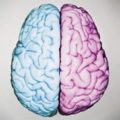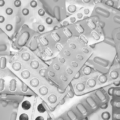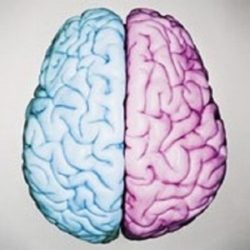In the course of trying to figure out why I have certain symptoms normally associated with intersex conditions, but do not fit the criteria for any of the conventional genetic causes of intersex, I have stumbled across what appears to be a gigantic medical and pharmaceutical industry disaster that has been quietly unfolding ever since WWII. This post is my latest attempt to bring the problem to wider public attention.
DES: A Hormone for Every Ailment
In the years during and immediately after WWII, rapid advances in chemistry suddenly made it possible to produce man-made versions of many of the hormones that occur naturally in the human body. Hormones control a wide range of biological processes involved in the day to day running of the human body, and are also key drivers of the development and maintenance of masculine and feminine attributes.
Doctors and the pharmaceutical industry quickly realised that hormones had tremendous potential as medicines, and they were rushed to market with comparatively little safety testing, and even in spite of clear evidence of harm during what animal experiments were performed.
The earliest of these substances was an artificial estrogen called diethylstilbestrol (or DES). DES was developed by a team of chemists in the UK in 1938. It is a completely man-made substance that has a chemical structure unrelated to naturally occurring estrogens. Nonetheless, the DES molecule has a similar shape to natural estrogen molecules, binds really well to estrogen receptors and acts as an extremely potent estrogen (one of the most powerful ever developed). Furthermore, it is active when taken by mouth, and it is comparatively easy to synthesize, so can be manufactured in bulk very cheaply. DES had all the right characteristics to become a blockbuster drug.
Because it was developed using public funds, DES was never patented. The people who developed it hoped that, by making the secret of its manufacture freely available, it would make a low cost source of estrogen available to women who needed it. However, US pharmaceutical giant Eli Lilly spotted a moneymaking opportunity, and quickly made DES their own, becoming the main manufacturer and distributor of the drug worldwide throughout the time it was used as a medicine
With this new drug in their armory, Lilly needed to find uses for it. One of the first uses they came up with was in pregnancy, as a treatment for preventing miscarriages and premature births. Their theory was that one main cause of miscarriage was inadequate hormone production, and that by supplementing a woman’s own hormones with DES, she would be less likely to miscarry. Never mind that the animal research showed no reduction in miscarriages,
“Dodds was always against the automatic prescribing of estrogen for any reason. He was sickened when he first heard about the work of Dr Karl John Karnaky in Houston, the first to use DES widely to “prevent miscarriages”. Dodds sent Karnaky a study that he himself had performed, showing that in rabbits and rats, the drug caused miscarriages.” (p37 of Barbara Seaman’s “The Greatest Experiment”)
More importantly, there was a whole series of experiments carried out between 1938 and 1941 at Chicago’s Northwestern University (here, here, here) showing that DES causes female development in male rat fetuses!
Consequences of Maternal DES
Undeterred, Eli Lilly pressed ahead, and through an aggressive marketing campaign and with a bit of arm twisting at the FDA, soon had DES licensed as a wonder drug for preventing miscarriages. Between 1940 and about 1980 (by which time it had largely been withdrawn from use as a miscarriage preventative), DES was used in somewhere in the region of 10 million pregnancies worldwide . In the US, it is estimated that 4.8 million children were exposed prior to 1971 when the FDA withdrew its approval, although doctors continued to use it off-label for several years after (p14 “DES Voices”, Pat Cody).
“It is estimated that DES was prescribed to between 2 and 10 million pregnant women world-wide as pills, injections, suppositories, and creams to prevent miscarriage between 1947–1971 … The exact number of women/fetuses prenatally-exposed to DES world-wide is unknown (IARC 2012). The majority of reports of DES use are from the U.S. where it is believed that between the 1940s and 1970s, 5 to 10 million people either consumed DES during pregnancy or experienced in utero exposures (IARC 2012). DES use was also popular in Europe and Australia, and like the U.S., many women did not know that they were taking DES. Therefore, estimated numbers of people reporting exposure during pregnancy or in utero are around 300,000 in the United Kingdom and 200,000 in France (Harris and Waring 2012).”
DES Daughters
The “DES daughters” from those pregnancies have since been acknowledged to have suffered all kinds of problems as a result of their exposure, including: very high rates of several kinds of cancer; infertility; abnormalities of their internal reproductive organs; several times greater risk of miscarriage and ectopic pregnancies; and various other health problems, including autoimmune disorders, osteopenia, degenerative disc disease, endometriosis, premature menopause, the list goes on and on. Everyone I have talked to who was prenatally exposed to DES seems to have health problems of one kind or another attributable to their exposure.
DES Sons
In contrast with the daughters, the official line has always been that the “DES sons” suffered virtually no ill effects as a result of their exposure. Based on what I’ve seen since first finding out about DES in 2011, that is not true at all, and in fact what it has done to us is exactly the same thing it did to the rats at Chicago’s Northwestern University: it caused us to develop as female instead of male during the time it was being administered.
Under the standard dosing schedule, increasing doses of DES was given to women with doses of across pregnancy reaching a 125mg in the last month of pregnancy (Physician’s Desk Reference, 1953). As a result of this graduated hormone exposure, we might expect relatively normal male development during the first trimester, but predominantly female development during the second and third trimesters. The first trimester is when genital takes place and physical sexual attributes develop. During the second and third trimesters, the main things still ongoing as far as development is concerned, is brain development. With this graduated dose of synthetic estrogens, we would expect relatively normal genital development although there is emerging evidence of alterations here too, but feminized brain development. In other words, with DES sons, we see a person who looks male but whose brain has predominantly or overwhelmingly, in a fair number of cases it seems, developed as female. The way this tends to manifest itself later in life is as a person who everyone regards as male, but who has a strong inner sense of being a woman.
Other common effects associated with DES exposure in males include subfertility or infertility, and hypogonadism (chronic below normal male testosterone production). I suspect this may also be a big risk factor for testicular cancer, however, this is unproven. All the genuine research into DES effects on males appears to have been discontinued by about 1980, and the total number of people studied is too small to assess cancer risk.
In Utero Synthetic Progestins
DES isn’t the only man-made hormone with gender bending properties to have seen widespread use during pregnancy. There is a class of hormones called progestins (which are all man-made versions of the hormone progesterone), that have also seen extensive use for miscarriage prevention. The first progestins were actually derivatives of testosterone. Although they act more like progesterone in adult women, in female fetuses they turned out to act more like testosterone. Female babies who had partially developed as male were being born throughout the 1950s as a result of progestin exposure. I have found a number of papers all published around 1960 reporting on cases of “progestin induced virilization”, so that appears to be when the medical community first realized there was a problem with these drugs. How long these androgenic progestins continued beyond this point I don’t know, nor do I know how many pregnancies they were used in in total. However, in her book “DES: The Complete Story”, the author, Cynthia Laitman, describes how she was given an androgenizing progestin alongside DES during her pregnancy in 1969, so it appears these gender bending drugs were being used throughout the 1960s too.
Unlike DES, progestins were never withdrawn. They are the main ingredient in birth control pills and other forms of hormonal contraception, and taken by several hundred million women every day for contraception. In fact some progestin formulations are still used for miscarriage prevention (allegedly these are non-androgenizing types of progestin, however, I think there’s a big risk they could be inducing female brain development in male babies).
In the course of trying to find out about the effects of DES on the unborn child, I came across a group of people whose babies were harmed by another hormone-based medicine, a drug called Primodos (marketed as Duogynon in Germany). A similar drug, called Gestest, was marketed in the United States. Here, the exposure occurred very early in the pregnancy, during the time organogenesis and limb development is taking place in the fetus, and before the process of sexual development is underway. As a result, the main effects have been severe, thalidomide like disabilities rather than abnormalities of sexual development (although, at least one member of their Facebook group had a Primodos exposed brother who was trans identified).
As with DES and the androgenizing progestins debacles, the pharmaceutical industry has been given a free pass by the governments of the countries involved, and the whole thing swept under the rug. An important fact about Primodos is that it contains exactly the same hormones as are used in birth control pills, the only difference being that the dose is higher.
A third group of people I’ve come across whose lives have been blighted by prenatal exposure to synthetic hormones, are in Hhorages France . The main issue this group is trying to highlight is that many of their hormone exposed children later committed suicide or developed serious psychiatric illnesses (although reading some of their published research, it appears that many of the children have intersex related abnormalities too).
My hope is that by alerting people to the harm so many have suffered as a result of being exposed in the womb to medically prescribed hormones, I can help to prevent such exposures from taking place in the future. I am also hoping this post and my Facebook page, Protect the unborn child from synthetic hormones, will help gain greater public acceptance for the transgender community; a much maligned group of people who, through no fault of their own, were born with brains that do not properly match their biological sex.
We Need Your Help
More people than ever are reading Hormones Matter, a testament to the need for independent voices in health and medicine. We are not funded and accept limited advertising. Unlike many health sites, we don’t force you to purchase a subscription. We believe health information should be open to all. If you read Hormones Matter, like it, please help support it. Contribute now.
Yes, I would like to support Hormones Matter.
This article was published originally on December 5, 2017.
















Here are 12 of the worst hormone disruptors, as part and parcel part of the Better Living with Chemistry’s Gits that Keep on Giving — Chronic Illnesses, Brain Disruption, Cancer and More. These are the Dirty Dozen, and unfortunately, there a hundreds of thousands now working alone and synergistically to alter human and animal physiology. From the Environmental Working Group:
https://www.ewg.org/consumer-guides/dirty-dozen-endocrine-disruptors
BPA
Some may say that imitation is the sincerest form of flattery, but do you really want a chemical used in plastics imitating the sex hormone estrogen in your body?
Dioxin
Dioxins are multi-taskers… but not in a good way! They form during many industrial processes when chlorine or bromine are burned in the presence of carbon and oxygen. Dioxins can disrupt the delicate ways that both male and female sex hormone signaling occurs in the body.
Atrazine
What happens when you introduce highly toxic chemicals into nature and turn your back? For one thing, feminization of male frogs. That’s right, researchers have found that exposure to even low levels of the herbicide atrazine can turn male frogs into females that produce completely viable eggs.
Phthalates
Did you know that a specific signal programs cells in our bodies to die? It’s totally normal and healthy for 50 billion cells in your body to die every day! But studies have shown that chemicals called phthalates can trigger what’s known as “death-inducing signaling” in testicular cells, making them die earlier than they should.
Perchlorate
Who needs food tainted with rocket fuel?! That’s right, perchlorate, a component in rocket fuel, contaminates much of our produce and milk, according to EWG and government test data. When perchlorate gets into your body it competes with the nutrient iodine, which the thyroid gland needs to make thyroid hormones. Basically, this means that if you ingest too much of it you can end up altering your thyroid hormone balance.
Fire retardants
What do breast milk and polar bears have in common? In 1999, some Swedish scientists studying women’s breast milk discovered something totally unexpected: The milk contained an endocrine-disrupting chemical found in fire retardants, and the levels had been doubling every five years since 1972! These incredibly persistent chemicals, known as polybrominated diphenyl ethers or PBDEs, have since been found to contaminate the bodies of people and wildlife around the globe – even polar bears. These chemicals can imitate thyroid hormones in our bodies and disrupt their activity. That can lead to lower IQ, among other significant health effects.
Lead
You may or may not like heavy metal music, but lead is one heavy metal you want to avoid. It’s well known that lead is toxic, especially to children. Lead harms almost every organ system in the body and has been linked to a staggering array of health effects, including permanent brain damage, lowered IQ, hearing loss, miscarriage, premature birth, increased blood pressure, kidney damage and nervous system problems. But few people realize that one other way that lead may affect your body is by disrupting your hormones.
Arsenic
Arsenic isn’t just for murder mysteries anymore. In fact, this toxin is lurking in your food and drinking water. If you eat enough of it, arsenic will kill you outright. In smaller amounts, arsenic can cause skin, bladder and lung cancer. Basically, bad news. Less well known: Arsenic messes with your hormones! Specifically, it can interfere with normal hormone functioning in the glucocorticoid system that regulates how our bodies process sugars and carbohydrates.
Mercury
Caution: That sushi you are eating could be hazardous to your health. Mercury, a naturally occurring but toxic metal, gets into the air and the oceans primarily though burning coal. Eventually, it can end up on your plate in the form of mercury-contaminated seafood. Pregnant women are the most at risk from the toxic effects of mercury, since the metal is known to concentrate in the fetal brain and can interfere with brain development. Mercury is also known to bind directly to one particular hormone that regulates women’s menstrual cycle and ovulation, interfering with normal signaling pathways.
Perfluorinated chemicals (PFCs)
The perfluorinated chemicals used to make non-stick cookware can stick to you. Perfluorochemicals are so widespread and extraordinarily persistent that 99 percent of Americans have these chemicals in their bodies. One particularly notorious compound called PFOA has been shown to be “completely resistant to biodegradation.” In other words, PFOA doesn’t break down in the environment – ever. That means that even though the chemical was banned after decades of use, it will be showing up in people’s bodies for countless generations to come. This is worrisome, since PFOA exposure has been linked to decreased sperm quality, low birth weight, kidney disease, thyroid disease and high cholesterol, among other health issues. Scientists are still figuring out how PFOA affects the human body, but animal studies have found that it can affect thyroid and sex hormone levels.
Organophosphate pesticides
Neurotoxic organophosphate compounds that the Nazis produced in huge quantities for chemical warfare during World War II were luckily never used. After the war ended, American scientists used the same chemistry to develop a long line of pesticides that target the nervous systems of insects. Despite many studies linking organophosphate exposure to effects on brain development, behavior and fertility, they are still among the more common pesticides in use today. A few of the many ways that organophosphates can affect the human body include interfering with the way testosterone communicates with cells, lowering testosterone and altering thyroid hormone levels.
Glycol Ethers
Shrunken testicles: Do we have your full attention now? This is one thing that can happen to rats exposed to chemicals called glycol ethers, which are common solvents in paints, cleaning products, brake fluid and cosmetics. Worried? You should be. The European Union says that some of these chemicals “may damage fertility or the unborn child.” Studies of painters have linked exposure to certain glycol ethers to blood abnormalities and lower sperm counts. And children who were exposed to glycol ethers from paint in their bedrooms had substantially more asthma and allergies.
+–+
And then, more holistically speaking, the times are a changing — Gender and Sexual Diversity
https://dissidentvoice.org/2021/11/pathologized-totalitarianism-101/
Gender Dysphoria is currently (and controversially) listed as a mental health issue, but as I mentioned earlier, ongoing study of both genetic ”brain sex” and Endocrine Disrupting Chemicals (EDCs) show the possibility of some biological causal factors. For instance, a researcher famous for his groundbreaking work in phantom limb syndrome has provided a great deal of evidence that the brain has innate, hard-wired templates for human anatomy. He reasoned that this hard-wired template may also be responsible for a person’s internal sense of gender and how this relates to one’s sexual anatomy, “both of which develop through different biological mechanisms, probably in utero”. Ultimately, he found support for this hypothesis that one’s internal sense of gender and sexual anatomical attributes may also be hard-wired in the brain.
Studies of EDCs show another, possibly concurrent potential that exposure to chemicals that simulate hormone characteristics can affect the signals sent out to determine psychological gender and biological sex, which appear to develop at different times during gestation. In all fairness, nothing is conclusively proven at this point (for the etiology of transexuality OR cissexuality), but a growing body of empirical data from EDC and brain studies tends to support an innate origin or component of intersexuality, transsexuality and cissexuality. I provide this information only to demonstrate the wide spectrum of diversity in nature — not to infer that an understanding of the etiology of homosexuality, heterosexuality, transsexuality, cissexuality, or any other variation is a prerequisite to respecting our basic rights and freedoms.
My brother, sister and I were all DES children. My brother died of AIDS 30 years ago after years of struggling as a very feminine homosexual. During his entire life he was weak, sick and fragile. My sister had breast tumors at 20 years old, I had cervical dysplasia at 20 and both of us suffer from degenerative disc disease. I am currently undergoing Stem Cell Therapy for the condition. My mother had to promise and sign all kinds of documents before she could get the proof that she was injected with DES with her pregnancy with my brother and took pills with my sister and I. This IS real
Currently, no. However, it might be possible to establish whether a person was prenatally exposed to synthetic hormones (or other drugs) by analysing their tooth enamel. Baby teeth in particular, if those still exist, however it’s possible even adult tooth enamel might still retain traces of drugs that were present during prenatal development, since the adult teeth actually start to form around week 20 of prenatal development. Although I think baby tooth enamel would be the best bet.
Unlike ordinary bone, which is continuously being broken down and rebuilt, once it’s formed, tooth enamel is sealed off from the rest of the body, and remains unaltered for the remainder of the life of the tooth. There’s a good chance drug traces could remain in there from the time the tooth was forming. This is just an idea I’ve had, as far as I know it’s not something anyone’s yet actually investigated.
It is all fine and well to postulate a theory, but I’d be interested to see evidence. Is there any test(s) one can administer that can conclusively say this child is a DES victim?
I appreciate your work, Hugh, in this area.
To the moderator
Below is the correct spelling of my email address. My apologies.
Hugh Easton has taken an extremely complex and not-understood medical tragedy and has shed light on how this occurred and the unthinkable results. I can’t imagine how many DES exposed DES daughters and sons have no idea why they are having serious and even deadly medical and psychological problems. Thank you, Mr. Easton, for your excellent article.
Signed,
A DES daughter who also has a birth son who is intersexed and has suffered horribly from my DNA.
Hugh, an excellent article with great information! Thank you for being an advocate for the DES Community